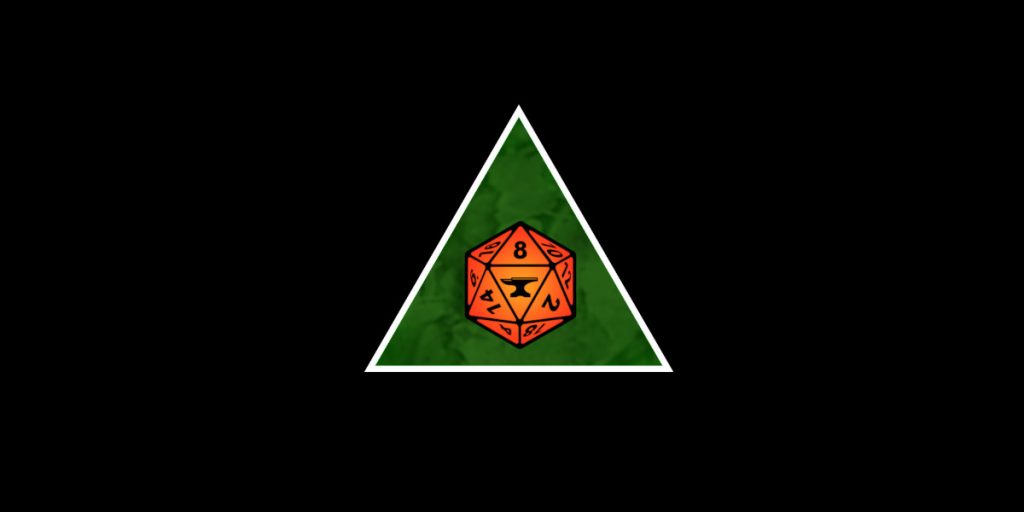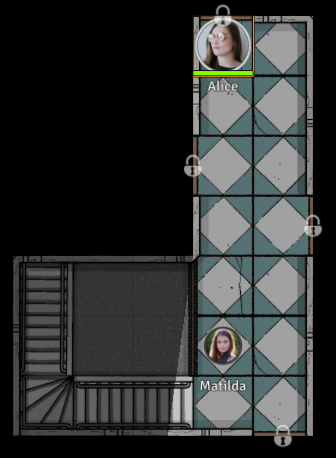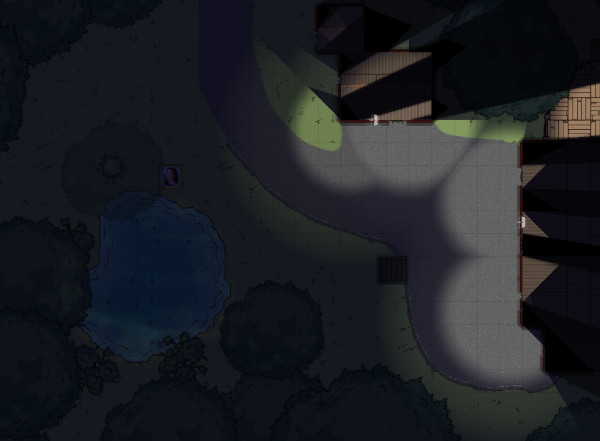The House in the Woods

Our first adventure of the year turned out to be a one-on-one designed to try out FoundryVTT. I chose to use DeltaGreen for this, since it’s a simple system and doesn’t require too much in the way of mechanics. I mostly wanted to see how the core side of Foundry worked, in terms of interacting with information between the players and the GM.
The advantages of using Delta Green were:
- We were both at least familiar with it.
- Really simple system, so I didn’t need to get bogged down in the rules
- The Delta Green character sheet in Foundry is nice and simple
- Delta Green has a high probability of actually being the system most likely to be the first to use Foundry for our group.
Downsides:
- I’ve never actually run Delta Green before, and the player knows both the system and setting a lot better than I do.
- The player knows both the system and setting a lot better than I do.
- The more ‘theatre of the mind’ approach for Delta Green games means a lot of the Foundry features didn’t actually get used.
It also didn’t help things that I set the adventure in New York. Most of what I know about the geography of New York comes from playing in Liberty City, and I spent too much time just trying to find suitable locations to base things.
The seed for the adventure started with a House, where I’d planned on doing a multi-level building. However, after spending a lot of time trying to get the multi-level module working properly in Foundry I decided to give up on that and focus more on testing out the basics.
Since it was a one-off, single player adventure, I started with a pre-generated character (Alice). She wasn’t a member of Delta Green, but was a journalist who had run across weirdness in the past and had encountered MIBs who had warned her off. She was now interested in finding out more, and was wanting to prove to the MIBs that she was more than capable of handling the truth, and was wanting to join their organisation. As part of her background, she had recently been trying to arrange a meet up with someone she had met online who went by the name “Captain Kirk”.
That gave a character that had a reason to investigate potentially dangerous things, and would also have to work alone without being able to call in back up.

The scene opened sometime in the summer of 2021 in New York, with Alice being woken by a Detective wanting to talk to her about a shooting. The previous afternoon, a crazy person had been shot outside of the office the where she normally worked (though was currently working from home). He had been shouting for her, and waving a gun around, and had been shot by police. On him had been an envelope which had Alice’s name on.
The detective was passing on the contents of the envelope, but the local police had been instructed to step back and stop any further investigation. Apparently a couple of people were coming in from out of town to take a look. Given that Alice had good inter-personal skills, she managed to get this information out of the detective, as well as the address of the crazy person – someone named Jack Kirk. He had been a Vietnam veteran, and had indeed been a captain in the army.
The envelope contained some pictures of a bloody operating table, and of a house with three children outside partially obscuring a ‘SOLD’ sign. Based on a partial phone number visible, it was somewhere in Main. There was also a letter:
14th August, 89
Dear Mike,
I hope you are well. I know we haven’t spoken in a long while, and you never answer your phone, but I pray that you will read this. I need your help. Your father needs your help. He locks himself away in the basement and refuses to let me in. He has something there, something he says that he shot in the woods, but he won’t show me what.
I snuck into his dark room, but there was just photos of a blood soaked table. Lots and lots of photos. He keeps saying that he’s found proof, but he won’t say of what.
I know it’s a way, but please come up to the house and try and speak sense into him. I know you parted on poor terms, but he did listen to you. He barely talks to me, and ignores your sisters. It has affected Anna badly, she just comes home from the cemetery and stares at the walls.
Mum
Alice did some digging around, and eventually pulled out a death certificate for Jack Kirk – from back in 83. She was unable to track down a precise location for the house, though apparently Jack had committed suicide in Milo.
Going to visit Jack Kirk’s apartment in Jackson Heights, she found a flat full of books on the occult as well as conspiracy theories. There was also writing scrawled on the inside of the door:
I am sane only when they say I am. I must not be sane.
There were photos of people up on the wall, along with notes and bits of string connecting them.
- Nigel Franks, a programmer living at Murray Hill apartments.
- Susan Yates, a nurse living in Brooklyn.
- Paul Higgens, apparently a homeless person.

There were also photos of Alice, and a collection of letters on the table, along with what looked like an address on a post it note. There were scrawled letters, most of which didn’t make much sense. General fragments from the letters which stood out were:
The camera doesn’t see them. No camera does. The ‘scientists’ want proof and don’t believe the drawings.
The voices are calling. I hear them at night. They hide in the woods and in the water.
They whisper. What Jack said was true. They wear masks, taking them from the Hillside.
They go somewhere cold. They flap but do not fly. I’ve seen people walk who are dead, worn like masks at Halloween.
When the Moon is full they come and go. They say they want me, but not for what. They talk to us. I sit and listen to them, they are in the walls. They are in the water.
I see them there, sitting on the stones at Hillside.
There was a covering letter as well:
Jack,
Here are a few of the letters my father sent me. I threw most of them away. Between when he found something and his death, he mostly repeated himself. Most of it is nonsense raving.
What really happened to you? Dad never forgave himself for what happened. I think that’s why he went over the edge in the end. Did you even bother to know that he was dead? Really dead that is.
Don’t put this on a computer. They see everything there.
Mike B.
Finally, there was a hand drawn sketch of some insect like creature with wings and a strange head with tentacles. The player immediately recognised it as a Mi-Go, which was pretty much what I was expecting.
Some follow up research dug out that the body of Susan Yates had been pulled out of the river about 9 days ago, her face and hands removed.
I was making heavy use of the journal feature in Foundry to share this information with the player, and was running into some difficulties. These are probably fixable with modules, but out of the box Foundry doesn’t work as well as Roll20 in this regard.
Journal entries can be put on the map, but you have to be in ‘journal mode’ to be able to see them. So whenever I gave the player permission to see them, I had to remind her to switch to journal mode before they actually became visible. Secondly, the ‘show to players’ option doesn’t automatically give the players permission to view the journals. They can see the window that pops up, but the notes don’t appear in their journal list. So currently it’s a two step process to show journal entries to players.

The next step was to head to the address on the post-it, which was an address not far from where Alice lived. In my attempt to find someone ‘right’, I ended up choosing the apartment block at the beginning of Leon. Which meant there ended up being a 12 year old girl named Matilda sitting at the top of the stairs once Alice got there.
This was the first place I’d decided to do a tactical map for. It wasn’t really necessary, but since I had a firm idea of what the place looked like due to Leon, and I was going to add some combat in, it seemed like a sensible thing to do.
It also gave me an opportunity to try out Dungeondraft for real. I do like how Foundry handles doors properly – in Roll20 you have to had a separate wall piece, and then move it out of the way. Foundry has actual door pieces, which a player can click on to open, unless they’re locked (which these were).
Getting into the flat itself, Alice found some documents and photos on the table, and a dead body covered in fungus in the bedroom. After taking some photos, and checking to make sure that the body and fungus was captured on the camera, she looked up to see the body struggling to its feet.
That gave us a chance to try the initiative/combat system – which worked though since she grabbed the documents and ran, there wasn’t much to try out there.
Running outside, she called the detective and left it for the police to deal with the zombie. Matilda had also given her a letter which was meant for Jack Kirk. There was enough information in the photos now for her to track down the full address of the house where the Bolton’s had grown up.
Jack,
I don’t know how you’re not dead. I want to think my father isn’t dead either, but I saw him go into the ground. I saw you go into the ground. Or was that a dream? There have been many dreams lately. Of the cemetery, of the woods. Maybe my dad isn’t insane now that he’s dead. Maybe that is the only path to making the voices stop for me.
I said I didn’t know anything, but I do. My dad killed one, and I saw the body. It was like nothing I’ve ever seen. But you couldn’t photograph it. It was something out of this world. They were there in the woods, in the stones. Taking the bodies and using them as clothes he said. Walking around Milo and nobody knew.
The voices say there are people watching now. That you’ve led them to me. That I’m the bait. And so are you. Someone keeps coming to the door, a woman. She is one of them that the things don’t like. They’re going to do something about her. They’re going to take her. Take all of them from here.
I know you were close with him. My dad only ever said that you saw something when you were serving with him. Something strange that you thought you brought back. I can’t imagine what it was. Or maybe I can. Was it the things in the woods? Or something else? Something worse? You said that insanity was your only escape from those things, maybe the other escape is the route dad took.
They want to also take me. To their home. To show me what it’s like. I don’t want to go.
Mike Bolton.
There was also a newspaper clipping, which confirmed Jack’s death.

Shortly thereafter, a couple of ‘agents’ turned up to take control of the situation.
The player was not really wanting to get involved in a potential fight with Mi-Go, and though she was thinking of taking a train the following morning up to Milo, I had the agents track her down this evening. There was some sharing of information, and since Alice wasn’t entirely keen on getting involved, the agent went off to handle the situation.
The rest of the adventure had been planned as talk to the family, find out that they’d been in contact with Mi-Go (and were now controlled by them) and maybe get into a fight with some Mi-Go (or join them). If that had happened with Alice alone, then I was planning on having the two agents turn up in the nick of time to rescue her.
Cthulhu players can be very cautious when it comes to investigating things – so there’s often a decision of “let’s ignore that” rather than charging in and trying to be heroes. So I’d half expected her to back out of investigating too much by herself, and it seemed like a reasonable place to draw things to a close. I’m sure Delta Green will contact her later and see if she’s interested in joining their ranks.

The final map for the house had been setup with lighting and audio effects. Woodland noises if the player ventures down towards the trees, and flicking lights outside the house and some special light effect over the pond. Foundry is definitely more powerful in this compared to Roll20.
There does come a point where too many special effects make it more like a computer game, which is one reason why I’ve shied away from 3D based VTT systems, but I have got used to using lighting on my maps in Roll20, so a few more options there are good.
I also like that you can have a second map layer for things like roofs and tree tops. They become translucent as a token walks under them, allowing players to see what’s underneath when they get close, but still giving the appearance of trees. You can’t just have a single second layer though – you need to have individual tiles for each tree if you want individual trees to fade as you go under them. There is a ‘radial’ option, but the size of the radius can’t be altered (as far as I can tell), so it isn’t very useful.
Overall though, Foundry worked reasonably well. I need to check to see if there’s a better way of presenting information to players with the journal permissions, but that was really the only main hurdle. It might be good to try a more combat orientated system at some point, though since I’d like to move away from D&D/Pathfinder for a bit I’ve deliberately avoided trying those systems.
I’m unlikely to actually move to Foundry any time soon though, simply because we’re in the middle of long running games in Roll20, and moving everything over would be too much like hard work. Next time I start something new though, it’s definitely going to be worth a look.